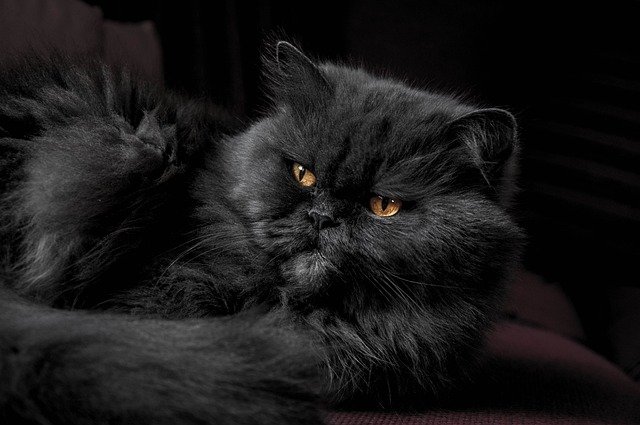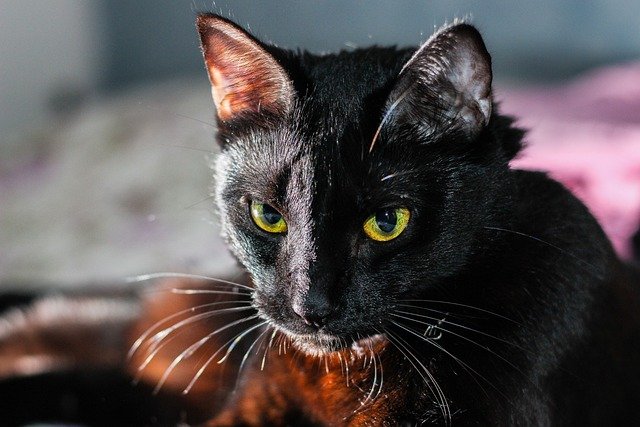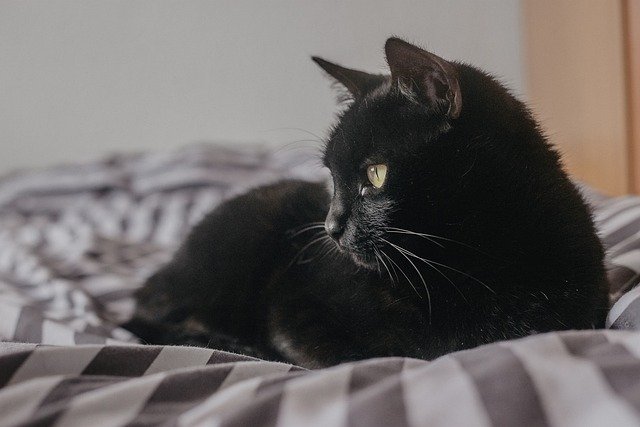The Ragdoll is cherished for its silky coat texture, large size, and docile personality, yet the black Ragdoll remains a controversial topic in the community.
Unlike traditional pointed Ragdolls, solid-colored varieties like solid black are not officially recognized by The International Cat Association (TICA) or the Cat Fancier’s Association (CFA). This has sparked debates over their legitimacy in pet competitions.
However, these cats have been around since the 1960s and are still sold by breeders today. While they lack the signature mask, ears, eyes, legs, and tails, they share the same affectionate nature, making them just as lovable.
In 1963, Ann Baker bred a solid black cat named Blackie with a white female named Josephine, producing the first litter of Ragdoll kittens.
As the breed developed, TICA and CFA set breeding standards, recognizing only specific colors like Blue, Cream, Chocolate, Lilac, Red (Flame), and Seal.
This led some to argue that black Ragdolls aren’t “true” Ragdolls. However, experts at Ragdoll Cat Advice have researched and confirmed that these rare cats exist. Some even resemble tuxedo cats, adding to their unique appeal.
If you’re eager to find out more, a thorough guide on the Breed Standard can help you learn about their history.
Can Ragdoll Cats Be Black? Understanding Their Genetics
Table of Contents
- 1 Can Ragdoll Cats Be Black? Understanding Their Genetics
- 2 Black Ragdoll Cat Variations and Patterns
- 3 Will Your Black Ragdoll Kitten Change Color? The Surprising Truth!
- 4 Facial Features of a Black Beauty
- 5 Black vs. Traditional Ragdoll: Personality Secrets?
- 6 Where to Find a Black Ragdoll Cat?
- 7 Conclusion – Is a Black Ragdoll Right for You?

The Ragdoll is best known for its silky coat texture, large size, and docile personality, but the black Ragdoll remains a controversial topic within the community.
Unlike the traditional pointed Ragdolls, solid-colored variations, including solid black, are not officially recognized by The International Cat Association (TICA) or the Cat Fancier’s Association (CFA).
This raises questions about their legitimacy in pet competitions, as most breeding standards exclude them. Despite this, they have existed since the 1960s and continue to be sold by breeders, captivating enthusiasts with their unique charm.
Understanding Ragdoll Coat Color Genetics
Ragdoll cats owe their distinct coat colors to the pointed gene, which causes the darker mask, ears, eyes, legs, and tails while keeping the body lighter.
This genetic trait explains why traditional Ragdolls don’t come in solid black. Instead, recognized colors include Blue, Cream, Chocolate, Lilac, Red (Flame), and Seal, as established by TICA and CFA.
Since solid-colored cats lack these defining points, some experts argue they aren’t “true” Ragdolls based on the Breed Standard.
Half Ragdoll Cat Black and White – Mixed Breeds with a Black Coat
While a purebred black Ragdoll doesn’t align with official breeding standards, mixed breeds can inherit black coats. A tuxedo-patterned Ragdoll, for example, results from crossbreeding and showcases a black and white coat.

Historically, Ann Baker bred a solid black cat named Blackie with a white female, Josephine, producing the first litter of Ragdoll kittens in 1963.
Over time, the breed developed, but black Ragdolls remained rare. Enthusiasts at Ragdoll Cat Advice have researched and found examples of these cats, proving that while they are rare, they do exist.
If you’re eager to find out more, a thorough guide on the Breed Standard can help you learn about their genetics and history.
Black Ragdoll Cat Variations and Patterns
While the black Ragdoll remains a controversial topic, some variations showcase unique color patterns. These include black and white, black and brown, and black and grey coats, often seen in mixed breeds.
Although solid-colored Ragdolls are not officially recognized by The International Cat Association (TICA) or the Cat Fancier’s Association (CFA), these cats do exist and have fascinated many in the community.
Their silky coat texture, large size, and docile personality make them just as lovable as their traditional counterparts.
Ragdoll Cat Black and White – A Tuxedo-Like Coat and Its Genetic Background
The black and white Ragdoll, often resembling a tuxedo pattern, results from mixed breeding. Since traditional Ragdolls inherit the pointed gene, a true Ragdoll cannot naturally develop this coat.
However, mixed breeds, such as those with a solid black parent, may feature this distinctive pattern. Historically, Ann Baker bred a solid black cat named Blackie with a white female, Josephine, leading to the first litter of Ragdoll kittens in 1963.
This early breeding experiment suggests that black-and-white variations have existed for decades, even though they don’t meet the official Breed Standard.
Ragdoll Cat Black and Brown – How Brown Tones Appear in Black-Coated Ragdolls

Some black Ragdolls develop brown undertones, which can be influenced by genetics, sun exposure, or coat dilution.
Though not recognized among official colors such as Blue, Cream, Chocolate, Lilac, Red (Flame), and Seal, these shades can appear due to recessive genes or mixed breeding.
Some breeders have noticed that black-coated Ragdolls may lighten over time, revealing subtle brown highlights, especially in certain lighting conditions.
This adds an intriguing layer to their silky coat texture and contributes to their rare and unique appeal.
Black and Grey Ragdolls: Smoky Coat Shades
While black and grey Ragdolls are not officially recognized, some cats inherit a smoky or diluted black coat. This variation can result from a dilution gene, which lightens black fur into a grey or charcoal-like shade.
Although TICA and CFA have not included these colors in their Breed Standard, experts, including Ragdoll Cat Advice, have researched and provided examples of these variations.
If you’re eager to find out more about these beautiful cuties, a thorough guide on their genetics can help you learn about their origins and unique characteristics.
Will Your Black Ragdoll Kitten Change Color? The Surprising Truth!
Many cat lovers wonder if a black Ragdoll kitten will stay the same color as it matures. Unlike traditional Ragdolls, which develop their points over time, solid-colored kittens do not undergo the same transformation.
However, factors like genetics, sunlight, and coat dilution can affect their final shade. Some black Ragdolls may show hints of brown, grey, or even a smoky effect as they grow.
Understanding these changes can help breeders and pet owners recognize the subtle differences in their cuties.
Do Black Ragdoll Kittens Stay Black? The Unexpected Answer!

A black Ragdoll kitten may retain its solid black coat, but some may develop a lighter hue due to genetic influences.
Unlike Seal Point or Blue Ragdolls, which are born white and darken over time, a solid black kitten typically keeps its color.
However, exposure to sunlight can introduce reddish-brown highlights, while some cats carry genes that lead to a smoky grey appearance.
Since TICA and CFA do not officially recognize these colors, black Ragdolls remain a controversial yet fascinating part of the community.
Persian-Ragdoll Mix and Its Influence on Coat Color
The Persian Black Ragdoll and White is a mix between a Ragdoll and a Persian, producing a tuxedo-like pattern. While purebred Ragdolls follow strict breeding standards, a Persian mix introduces new colors and coat patterns.
This blend often results in a fluffier, more rounded face, combined with the silky coat texture and docile personality of the Ragdoll.
Since black and white is not part of the official Breed Standard, these mixed kittens are considered unique but not eligible for pet competitions recognized by TICA or CFA.
However, they are still sought after for their affectionate nature and large size, making them wonderful companions.
Facial Features of a Black Beauty
The facial features of a black Ragdoll cat are just as striking as their unique coat. Unlike traditional Ragdolls, which are known for their blue eyes and pointed patterns, black Ragdolls may have varying eye colors, nose pigmentation, and even subtle color variations in their fur.
Let’s explore these distinctive traits.
Can Ragdolls Have Black or Dark Eyes?

Traditional Ragdolls, recognized by TICA and CFA, always have blue eyes due to the pointed gene. However, in solid-colored Ragdolls, the eye color can range beyond blue.
Here’s how it varies:
| Ragdoll Type | Possible Eye Colors |
| Traditional Pointed Ragdoll | Blue (always) |
| Black Ragdoll (Solid-Colored) | Green, Gold, Copper, Hazel |
| Mixed Breed Ragdoll (Black & White, Persian Mix, etc.) | Blue, Green, Gold, Copper |
While some may describe very dark brown or deep amber eyes as appearing “black,” true black eyes do not exist in Ragdolls. The genetics of solid-colored black Ragdolls allow for a wider variety of eye shades, making them different from their pointed relatives.
Black Ragdoll Nose vs. Traditional Ragdoll Noses
A black Ragdoll’s nose can range in color depending on its genetics and coat variation. Unlike Seal Point Ragdolls, which have dark brown noses, or Blue Ragdolls, which have a bluish-grey tint, a solid black Ragdoll typically has a completely black nose.
Here’s a breakdown of nose colors based on coat variations:
| Ragdoll Coat Color | Typical Nose Pigmentation |
| Black Ragdoll | Black |
| Black & White Ragdoll (Tuxedo) | Black or Pink-Black Mix |
| Chocolate Ragdoll | Dark Brown |
| Seal Point Ragdoll | Dark Brown |
| Blue Ragdoll | Bluish-Grey |
| Lilac Ragdoll | Light Grey-Pink |
The black nose of a solid-colored Ragdoll adds to its charm, blending seamlessly with its dark fur. However, in mixed breeds, especially those with tuxedo patterns, a pinkish hue may appear due to the influence of white fur patches.
These subtle differences in eyes and nose pigmentation make black Ragdolls unique and sought after by those who appreciate their rare beauty.
Black vs. Traditional Ragdoll: Personality Secrets?

The Ragdoll is famous for its docile personality, affectionate nature, and tendency to go limp when held. But do black Ragdoll cats share the same temperament?
Despite the controversy surrounding their legitimacy in pet competitions, solid-colored Ragdolls have the same gentle, friendly, and social traits as their traditional counterparts.
They thrive in family environments, get along with children and other pets, and love cuddles just like any other Ragdoll.
One major difference is their recognition status. Since black Ragdolls do not meet the breed standards set by TICA and CFA, some believe they have a different personality.
However, this is a misconception—their behavior is shaped by breeding, environment, and individual temperament, not just their coat color.
Dark-Coated Ragdolls: Myths and Misconceptions
A bizarre misconception exists regarding black Ragdoll cats and their connection to people. Some believe that black Ragdolls behave differently depending on who owns them, but this has no scientific basis.
Just like black cats in general, they have faced unfounded myths and superstitions throughout history. Here are some common myths about black Ragdolls and the truth behind them:
| Myth | Reality |
| Black Ragdolls are more aggressive | They have the same gentle temperament as other Ragdolls. |
| Black Ragdolls are unlucky | Superstitions about black cats vary by culture but have no factual basis. |
| Black Ragdolls don’t bond with owners | Ragdolls are known for their strong attachment to their humans, regardless of color. |
| Black Ragdolls act differently with different people | A cat’s behavior is based on training, socialization, and personality, not race or culture. |
This black cat is just as loving, playful, and family-friendly as any other Ragdoll. While coat color plays a role in recognition by cat associations, it has no impact on temperament. Whether black, white, tuxedo, or traditional, a Ragdoll is always a Ragdoll—gentle, affectionate, and the perfect companion.
Where to Find a Black Ragdoll Cat?

Finding a black Ragdoll cat can be challenging, as most official breeders focus on traditional pointed Ragdolls. However, there are still ways to adopt or buy one. Some breeders specialize in solid-colored Ragdolls, while rescue centers may have mixed Ragdolls with black coats.
Breeders vs. Rescue Centers
| Option | Pros | Cons |
| Breeders | Health-tested kittens, pedigree history, potential for a pure Ragdoll mix | Expensive, may take time to find a breeder offering black Ragdolls |
| Rescue Centers | Affordable, helps a cat in need, mixed breeds may still have Ragdoll traits | Hard to find a black Ragdoll, uncertain lineage |
Can You Adopt or Buy a Black Ragdoll Cat?
- Buying: Look for reputable breeders who specialize in solid-colored Ragdolls. Always check their health records and verify the kitten’s lineage.
- Adopting: Many Ragdoll rescues and general cat shelters may have black Ragdoll mixes, especially those with a half-Ragdoll background.
If you’re determined to own a black Ragdoll, start by researching breeders’ websites, TICA listings, or local shelters. Patience is key, as these rare cuties may take time to find!
Conclusion – Is a Black Ragdoll Right for You?
A black Ragdoll cat shares the same large size, silky coat texture, and docile personality as traditional Ragdolls but comes with controversy due to its solid-colored coat.
While it is not officially recognized by organizations like TICA or CFA, these cuties still make loving companions.
Their calm temperament, affectionate nature, and adaptability make them great pets for families, singles, and even multi-pet households.
However, if you’re looking for a show-quality Ragdoll, keep in mind that only pointed colors are accepted in pet competitions.
Where to Find One?
If you’re eager to find out more or adopt a black Ragdoll, consider checking:
✔️ Breeders – Some Ragdoll breeders specialize in solid-colored cats.
✔️ Rescue Centers – You might find mixed Ragdolls with black or tuxedo-like coats.
✔️ Online Listings & Websites – Platforms featuring Ragdoll kittens for sale or adoption.
Before getting one, ensure you research thoroughly, check health records, and verify breeding standards. A black Ragdoll may not meet official breed standards, but it can still be a loving and devoted companion!
Frequently Asked Questions
Is a black Ragdoll cat rare?
Yes, black Ragdoll cats are considered rare because traditional Ragdolls have pointed coats, which means their fur is typically lighter in color. Solid black Ragdolls do exist, but they are not officially recognized by major cat associations.
Can Ragdoll cats have black fur?
Technically, Ragdolls cannot have black fur under official breed standards. However, some solid black Ragdoll kittens appear due to breeding variations, especially in non-traditional or mixed litters.
What is the personality of a black Ragdoll cat?
A black Ragdoll cat has the same docile, affectionate, and social personality as a traditional Ragdoll. They are known for their gentle nature, love for human companionship, and tendency to go limp when picked up.
How much do black Ragdoll cats cost?
The price of a black Ragdoll cat varies but is generally lower than a traditional Ragdoll due to the lack of official recognition. Expect to pay anywhere from $500 to $1,500, depending on the breeder and lineage.
Is black Ragdoll a lazy cat?
Like all Ragdolls, the black Ragdoll cat enjoys lounging and relaxing. While they are playful, they are generally calm, easygoing, and not overly active.
Why is Ragdoll so expensive?
Ragdolls are expensive because they are a purebred, in-demand breed with specific breeding standards. Their silky coat texture, large size, and affectionate personality make them highly desirable, and responsible breeding requires time, effort, and health testing.
Is black Ragdoll a friendly cat?
Yes, a black Ragdoll cat is just as friendly, affectionate, and loving as any other Ragdoll. They enjoy human company, social interactions, and cuddles.
What is the cutest cat breed?
While beauty is subjective, the Ragdoll breed is often considered one of the cutest cats due to their blue eyes, fluffy coats, and sweet expressions. Many also adore black Ragdolls for their unique charm.
How long do black Ragdoll cats live?
A black Ragdoll cat has a similar lifespan to other Ragdolls, typically living 12 to 17 years with proper care, nutrition, and regular vet check-ups.
Previous Posts:

